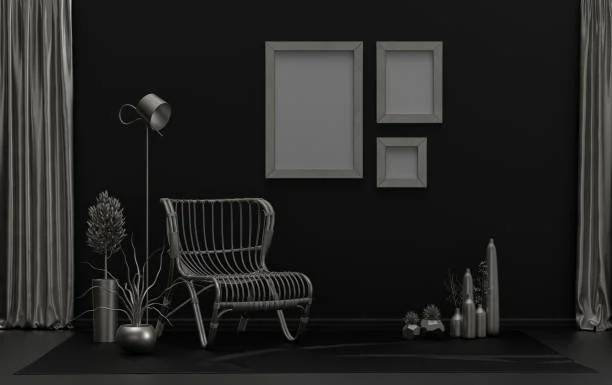Black used to be the color people avoided on walls. Too dark. Too moody. Too risky. Not anymore. Designers and homeowners are waking up to the drama and depth it brings. Now, black wallpaper is one of the most talked-about trends in modern interiors. It’s bold. It’s confident. It’s sophisticated. And when done right, it transforms any space into something unforgettable. This isn’t about covering your walls in darkness. It’s about creating mood, balance, and contrast that demand attention.
Let’s break down why black wallpaper works, where to use it, and how it can completely change how your home or business feels.
Why Black Wallpaper Works So Well
Black isn’t just a color. It’s a statement.
It’s the color of strength, elegance, and control. When applied to a wall, it does something magical—it defines the room.
Here’s why designers swear by it:
- It adds instant depth. Black recedes visually, creating the illusion of more space when paired with lighter tones or natural light.
- It elevates everything else. Gold accents look richer. White furniture looks sharper. Art pops off the wall.
- It creates atmosphere. Whether cozy or dramatic, black sets the tone better than any other hue.
Black wallpaper isn’t about making a room darker—it’s about making it more intentional.
The Psychology of Black
Black has always carried emotional weight. It’s mysterious. Authoritative. Clean.
In design, it can make people feel grounded, focused, and calm.
That’s why luxury brands use it. It signals confidence and exclusivity.
Bringing that same feeling into your living space isn’t difficult—it just requires smart balance.
Combine black walls with warm textures like wood, linen, or brass. Suddenly, the space feels rich, not cold.
Patterns That Make Black Shine
Flat black can be striking, but patterned wallpaper adds movement and dimension.
Modern wallpaper designers use metallic inks, matte finishes, and subtle textures to catch light differently throughout the day.
Here are a few standout styles trending right now:
- Geometric designs: Clean lines. Sharp symmetry. Perfect for offices or minimalist homes.
- Floral prints: Unexpected and elegant. Adds a romantic edge to bedrooms or hallways.
- Textured patterns: Think faux leather, linen, or grasscloth. They add tactile depth.
- Art deco motifs: Timeless. Glamorous. Perfect for entryways and dining rooms.
Each pattern changes the mood completely. Some whisper luxury. Others shout creativity.
That’s the beauty of black—it’s a canvas for personality.
Where to Use Black Wallpaper
The instinct might be to limit it to one accent wall, but designers are proving that full rooms can handle it beautifully—if you get the details right.
Here’s where black wallpaper really shines:
1. The Living Room
It adds sophistication instantly. Use matte black walls with velvet or leather furniture. Add metallic or marble accents for contrast.
Pro tip: keep lighting layered. Combine overhead fixtures with wall sconces and lamps. The goal is to create glow, not glare.
2. The Bedroom
Black creates calm. It absorbs light, helping the body relax.
A soft black wallpaper with subtle texture behind your bed turns it into a focal point. Pair with ivory bedding and warm lighting. Luxurious but peaceful.
3. The Office
Black boosts focus. It eliminates distraction.
In home offices, it looks sharp on camera during video calls and pairs beautifully with natural wood desks.
4. The Bathroom
Yes, it works there too.
Glossy or metallic black wallpaper reflects light, adding drama in small spaces. Pair it with brass fixtures and white tile.
5. The Dining Room
Nothing says elegant like a black dining wall.
With a chandelier or pendant lighting above, the space becomes intimate and refined. Guests notice. Every time.
Lighting: The Secret Ingredient
Lighting makes or breaks dark wallpaper.
Black absorbs light. So the more intentional your lighting plan, the better it looks.
Use three layers:
- Ambient: Overhead lighting or recessed fixtures for general brightness.
- Accent: Spotlights, wall sconces, or uplights to highlight decor or texture.
- Task: Lamps or pendant lights for practical zones.
Soft, warm bulbs (2700K–3000K) keep black tones cozy instead of harsh.
If your room has large windows, natural light becomes your best friend. Morning light on a matte black wall? Breathtaking.
The Balance Game: Contrast Is Key
Black needs balance. Too much of it, and a room can feel heavy.
That’s where contrast comes in.
Mix it with:
- White: Crisp and timeless.
- Wood: Adds warmth and natural softness.
- Metallics: Creates glam and light reflection.
- Color pops: Deep greens, burnt orange, or blush pink for personality.
The contrast gives the eye something to play with. It defines edges and keeps the design alive.
Texture: The Unsung Hero
Texture turns black from flat to fascinating.
Matte black feels modern and understated. Satin finishes feel sleek and polished. Embossed or metallic textures add movement and depth.
Light interacts differently with each finish, changing the mood throughout the day.
For living areas, matte or velvet-like finishes feel cozy. For powder rooms or formal dining spaces, metallic or lacquered finishes add luxury.
The secret is in layering.
Black Wallpaper in Modern Homes
Modern design trends love simplicity—but not emptiness.
Black wallpaper adds richness without clutter. It frames minimalist furniture. It defines architectural lines.
In open-concept homes, black walls can create separation between spaces without physical barriers. A dark wall behind a dining table or sofa instantly zones the room.
And in lofts or industrial spaces, black complements raw materials like concrete, brick, and steel perfectly.
Using It in Commercial Spaces
Businesses are embracing black, too.
Retail stores use it to highlight products. Restaurants use it to make lighting and decor pop. Offices use it to communicate authority and style.
When paired with branding colors or illuminated signage, black walls make a powerful impression.
It’s modern professionalism in visual form.
Common Myths About Black Wallpaper
“It makes rooms smaller.”
Not always. With good lighting and contrast, black can actually make rooms feel bigger by softening corners and adding visual depth.
“It’s too dark.”
Dark doesn’t mean depressing. Black paired with warm tones feels intimate and inviting.
“It’s too bold for small spaces.”
Wrong. In small rooms like powder baths or entryways, it creates impact and sophistication.
The key is balance and intention.
How to Install and Maintain It
Installing black wallpaper is similar to any other, but precision matters.
Black shows seams more clearly than light colors. Always measure twice, cut once, and align patterns carefully.
If you’re new to wallpapering, hire a professional installer. It’s worth it.
Maintenance is simple—just wipe gently with a soft, damp cloth. Avoid harsh chemicals or abrasives that can dull the finish.
Why Black Is the Future of Bold Design
Minimalism had its moment. Now people want depth.
They want rooms with character. Walls that feel like art. Spaces that reflect personality instead of neutrality.
That’s what black delivers.
Design trends are shifting toward darker, moodier interiors for a reason. They feel sophisticated. They photograph beautifully. And they make everything else look intentional.
Whether you’re refreshing a single room or redesigning an entire space, black wallpaper is a risk that pays off. Every time.
Final Thoughts
Black is confidence.
It’s timeless. Elegant. Striking.
When you choose black wallpaper, you’re not following a trend—you’re setting one.
It’s a design move that says you know what you want your space to feel like—bold, modern, unforgettable.
The walls don’t fade into the background anymore. They become part of the story.
And once you see how powerful that transformation is, you’ll never go back to beige.
Keep your imagination alive — explore design brilliance online!






